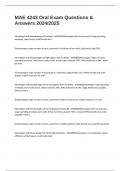MAE 4243 Oral Exam Questions &
Answers 2024/2025
Advantages and disadvantages of Turbojet - ANSWERSAdvantages: few moving parts, large operating
envelope, static thrust, small frontal area
Disadvantages: large number of parts, expensive, low thrust at low mach, high noise, high TSFC
Advantages and disadvantages of high bypass ratio Turbofan - ANSWERSAdvantages: large sub-sonic
operating envelope, much more static thrust, much better subsonic TSFC, FOD protection of HPC, lower
jet noise
Disadvantages: large number of moving parts, expensive, large frontal area, limited to high sub-sonic
speeds, engine response, air start
Advantages and Disadvantages of the Low Bypass Ratio Turbofan - ANSWERSAdvantages: large operating
envelope, more static thrust, better subsonic TSFC, FOD protection of HPC, large afterburner possible,
lower jet noise
Disadvantages: large number of parts, expensive, medium frontal area, engine response, air start
Advantages and Disadvantages of the Turboprop/Turboshaft - ANSWERSAdvantages: few moving parts,
large operating envelope, best static thrust, best low subsonic TSFC, constant RPM possible, low noise,
propeller reverse
Disadvantages: large number of parts, expensive, complex gearbox, large frontal area, propeller governor
Advantages and Disadvantages of the Ramjet/SCRamjet - ANSWERSAdvantages: no moving parts, good
efficiency at high speed, small in diameter
, Disadvantages: efficiency drops off at high Mach number, cannot produce thrust from stand still, not
efficient at lower speeds
Identify and state the purpose of the Inlet - ANSWERSStation 1-2
What -> subsonic or supersonic, uniform flow at Mach=5 to compressor
Why -> reduce distortion for good operability
How -> subsonic: increase area, supersonic: decrease then increase area, minimize flow turning
Design Challenges -> total pressure recovery, stealth, weight, frictional losses
Identify and state the purpose of the Fan/Compressor - ANSWERSStation 2-3
What -> add energy to flow, raise the total pressure
Why -> prepare airflow for combustion
How -> series of rotors and stators, adds rotational velocity then diffuse
Design challenges -> adverse pressure gradient, reduce parts count and weight, isentropic efficiency, FOD
and fatigue
Identify and state the purpose of the Combustor/Afterburner - ANSWERSStation 3-4
What -> add energy to flow, raise total temperature
Why -> create energy imbalance, increase internal energy
How -> mix fuel-air, anchor flame, 20% air in primary zone, 80% air for cooling and dilution
Design challenges -> flame holding, thermal fatigue, temp limit, overcome fanno and Rayleigh losses to
total pressure
Identify and state the purpose of the Turbine - ANSWERSStation 4-5
What -> extract energy from flow, expand flow, reducing total pressure
Why -> power the compressor
How -> series of rotors and stators, chock the flow then expand through nozzle, reaction vs. impulse
Design Challenges -> temp limit, reduce cooling, tensile and thermal load, isentropic efficiency, reduce
parts and weight




